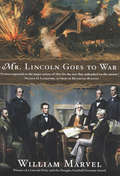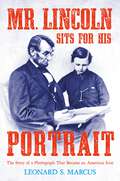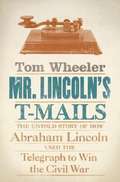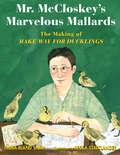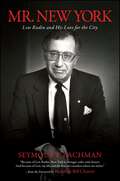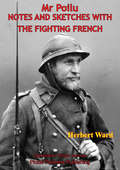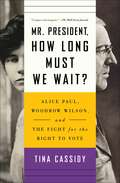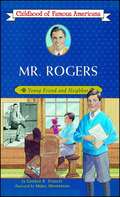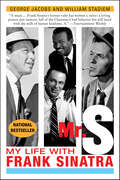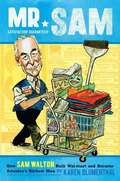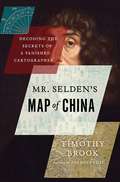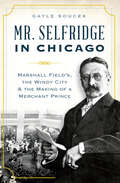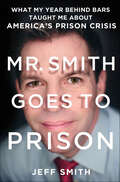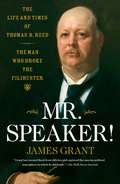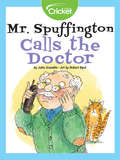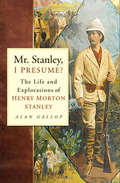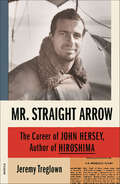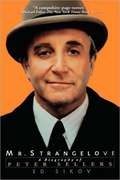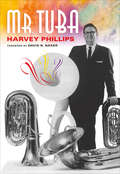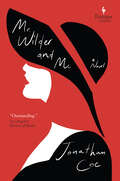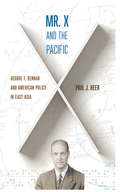- Table View
- List View
Mr. Lincoln Goes to War
by William MarvelAn account of how America&’s greatest crisis began, by &“the Civil War&’s master historical detective&” (Stephen W. Sears, author of Chancellorsville). This groundbreaking book investigates the mystery of how the Civil War began, reconsidering the big question: Was it inevitable? The award-winning author of Andersonville and Lincoln&’s Autocrat vividly recreates President Abraham Lincoln&’s first year in office, from his inauguration through the rising crisis of secession and the first several months of the war. Drawing on original sources and examining previously overlooked factors, he leads the reader inexorably to the conclusion that Lincoln not only missed opportunities to avoid war but actually fanned the flames—and often acted unconstitutionally in prosecuting the war once it had begun. With a keen eye for the telling detail, on the battlefield as well as in the White House, this is revisionist history at its best, not sparing anyone, even Abraham Lincoln. &“A brilliant narrative that reveals the possibilities of the past that were squandered by historical figures who seem so unassailable and godlike to us today.&” —Peter S. Carmichael, author of The Last Generation &“The most provocative account of events in 1861 in a generation. Readers who think they understand the Civil War&’s first year and the roles played by Abraham Lincoln, Nathanial Lyon, Charles Stone, and a host of others should brace themselves for a bold new perspective.&” —A. Wilson Greene, author of Breaking the Backbone of the Rebellion
Mr. Lincoln Sits for His Portrait: The Story of a Photograph That Became an American Icon
by Leonard S. MarcusMr. Lincoln Sits for His Portrait is a unique middle-grade depiction of America’s sixteenth president, through the story of one famous photograph, written by award-winning author Leonard S. Marcus. On February 9, 1864, Abraham Lincoln made the mile-long walk from the Executive Mansion to photographer Mathew Brady's Washington, DC, studio, to be joined there later by his ten-year-old son, Tad. With a fractious re-election campaign looming that year, America's first media-savvy president was intent on securing another portrait that cast him in a favorable light, as he prepared to make the case for himself to a nation weary of war. At least four iconic pictures were made that day. One was Lincoln in profile, the image that later found its way onto the penny; two more would be adapted for the 1928 and 2008 five-dollar bills. The fourth was a dual portrait of Lincoln and Tad. The pose, featuring Lincoln reading to his son, was a last-minute improvisation, but the image that came of it was—and remains—incomparably tender and enduringly powerful. Immediately after the president’s murder the following year, the picture of Lincoln reading to his son became a mass-produced icon—a cherished portrait of a nation’s fallen leader, a disarmingly intimate record of a care-worn father's feeling for his child, and a timeless comment on books as a binding force between generations.
Mr. Lincoln's High-tech War: How The North Used the Telegraph, Railroads, Surveillance Balloons, Ironclads, High-powered Weapons, and More to Win the Civil War
by Roger Macbride Allen Thomas B. AllenThis history lesson for general readership walks the reader through the American Civil War by way of the technologies that allowed Abraham Lincoln and the Union forces to triumph over the Confederacy. The text, loosely laid out in the style of a 19th century newspaper, is supported by b&w primary source materials (photographs, paintings, and political cartoons), as well as contemporary illustrations. Chapters address the involvement in the war of military mass production and the Dahlgren gun, the hot-air balloon, land torpedoes (used by the South), naval technology, photography, the Spencer Repeating Rifle, and civic constructions such as bridges and railroads, among other technologies. Annotation ©2009 Book News, Inc. , Portland, OR (booknews. com)
Mr. Lincoln's T-Mails: The Untold Story of How Abraham Lincoln Used the Telegraph to Win the Civil War
by Tom WheelerThe story of how Lincoln adapted to a new medium of communication during a period of social and technological innovation.
Mr. Lincoln's Whiskers
by Boyds Mills Press Staff Karen B. WinnickAbraham Lincoln was the first President of the United States to wear a beard. What gave him the idea was a letter he received from an eleven-year-old girl from Westfield, New York named Grace Bedell. "Dear Sir," she wrote, "... if you will let your whiskers grow I will try to get (my brothers) to vote for you. You would look a great deal better for your face is so thin. All the ladies like whiskers and they would tease their husbands to vote for you..."
Mr. McCloskey's Marvelous Mallards: The Making of Make Way for Ducklings
by Emma Bland SmithThis behind-the-scenes look at the creation of the classic and beloved picture book Make Way for Ducklings will captivate young artists, writers, readers, and animal lovers alike.While writing and illustrating the beloved picture book Make Way for Ducklings, Robert McCloskey brings a flock of ducklings into his tiny New York City apartment. But an artist + a bunch of ducklings in his apartment = chaos! There are ducklings in the bathtub and ducklings in the kitchen, quacking at dawn and sitting on his desk. Can he learn to draw them just right before they grow too big? This glimpse into the creation of a much-loved story for kids is a must-read for fans of children&’s books, or for anyone who is interested in the creative process and the importance of persistence. &“Emma Smith has done a bang-up job imagining how my father wrote Make Way for Ducklings. I enjoyed reading her book.&” —Jane McCloskey, daughter of Robert McCloskey and author ofRobert McCloskey: A Private Life in Words and Pictures&“A wonderfully rollicking rendition of the story behind the story.&” —Gary D. Schmidt, Newbery Honor-winning author of books for children and author of Robert McCloskey
Mr. New York: Lew Rudin and His Love for the City (Excelsior Editions)
by Seymour P. LachmanLew Rudin was one of New York City's most influential power brokers in the latter part of the twentieth century, but he was also one of its most indefatigable boosters. Born in the Throgs Neck section of the Bronx on April 4, 1927, Rudin rose to become cochairman, with his brother, Jack, of one of New York's oldest real estate dynasties, Rudin Management. It is for his civic involvement, however, that he is best remembered. Whether helping to get the New York City Marathon off the ground, or rallying corporate and labor leaders to come to the city's aid during the fiscal crises of the 1970s, Rudin worked tirelessly on behalf of the city he loved. The Association for a Better New York, which he founded in 1971 in response to growing concerns about the city's decline, continues to play a vital role in virtually every area of municipal life, from transportation to education.In Mr. New York, Seymour P. Lachman chronicles Rudin's life and interesting times, and his love affair with the city he never ceased to believe in. Drawing on published materials as well as personal interviews with family members, business associates, and federal, state, and city officials, Lachman paints a portrait of a man who, by the time of his death in 2001, had truly earned the nickname "Mr. New York."
Mr. Poilu; Notes And Sketches With The Fighting French [Illustrated Edition]
by Herbert WardIllustrated with 45 pictures and vignettes many in colour.Herbert Ward was a patriotic and passionate Englishman at an unfortunate juncture in his life during the First World War, he was over 40 and would not be allowed to enlist in the British Army for service in the fields of Flanders under ordinary circumstances. However this was a minor issue when the Kaiser's German hordes advanced to within artillery range of his home in France; he at once gave over his large estate to the Red Cross and argued and created so much fuss that he was finally allowed to join the famous No. 3 Convoy of the British Ambulance Committee. He worked with at a furious rate and his work with the units, which was attached to the French army at the time, surely saved many lives of the "Poilus" that he so admired. Despite the huge burdens that work placed him under he set about recording the admirable bravery and courage of the Allied French soldiers fighting the common German foe.
Mr. President, How Long Must We Wait?: Alice Paul, Woodrow Wilson, and the Fight for the Right to Vote
by Tina CassidyIn this &“heroic narrative&” (The Wall Street Journal), discover the inspiring and timely account of the complex relationship between leading suffragist Alice Paul and President Woodrow Wilson in her fight for women&’s equality. Woodrow Wilson lands in Washington, DC, in March of 1913, a day before he is set to take the presidential oath of office. He is surprised by the modest turnout. The crowds and reporters are blocks away from Union Station, watching a parade of eight thousand suffragists on Pennsylvania Avenue in a first-of-its-kind protest organized by a twenty-five-year-old activist named Alice Paul. The next day, The New York Times calls the procession &“one of the most impressively beautiful spectacles ever staged in this country.&” Mr. President, How Long Must We Wait? weaves together two storylines: the trajectories of Alice Paul and Woodrow Wilson, two apparent opposites. Paul&’s procession of suffragists resulted in her being granted a face-to-face meeting with President Wilson, one that would lead to many meetings and much discussion, but little progress for women. With no equality in sight and patience wearing thin, Paul organized the first group to ever picket in front of the White House lawn—night and day, through sweltering summer mornings and frigid fall nights. From solitary confinement, hunger strikes, and the psychiatric ward to ever more determined activism, Mr. President, How Long Must We Wait? reveals the courageous, near-death journey it took, spearheaded in no small part by Alice Paul&’s leadership, to grant women the right to vote in America. &“A remarkable tale&” (Kirkus Reviews) and a rousing portrait of a little-known feminist heroine, this is an eye-opening exploration of a crucial moment in American history one century before the Women&’s March.
Mr. Putin
by Fiona Hill Clifford G. GaddyFrom the KGB to the Kremlin: a multidimensional portrait of the man at war with the West. Where do Vladimir Putin's ideas come from? How does he look at the outside world? What does he want, and how far is he willing to go?The great lesson of the outbreak of World War I in 1914 was the danger of misreading the statements, actions, and intentions of the adversary. Today, Vladimir Putin has become the greatest challenge to European security and the global world order in decades. Russia's 8,000 nuclear weapons underscore the huge risks of not understanding who Putin is. Featuring five new chapters, this new edition dispels potentially dangerous misconceptions about Putin and offers a clear-eyed look at his objectives. It presents Putin as a reflection of deeply ingrained Russian ways of thinking as well as his unique personal background and experience.Praise for the first editionIf you want to begin to understand Russia today, read this book. -Sir John Scarlett, former chief of the British Secret Intelligence Service (MI6)For anyone wishing to understand Russia's evolution since the breakup of the Soviet Union and its trajectory since then, the book you hold in your hand is an essential guide.-John McLaughlin, former deputy director of U.S. Central IntelligenceOf the many biographies of Vladimir Putin that have appeared in recent years, this one is the most useful. -Foreign AffairsThis is not just another Putin biography. It is a psychological portrait. -The Financial TimesQ: Do you have time to read books? If so, which ones would you recommend? "My goodness, let's see. There's Mr. Putin, by Fiona Hill and Clifford Gaddy. Insightful." -Vice President Joseph Biden in Joe Biden: The Rolling Stone Interview.
Mr. Republican: A Biography of Robert A. Taft
by James T. PattersonComprehensive biography of the US President.
Mr. Rogers: Young Friend and Neighbor
by George E. StanleyA childhood biography of one of the most beloved child educators and neighbors of the 20th-century.
Mr. S: My Life with Frank Sinatra
by William Stadiem George Jacobs"Mr. S: My Life with Frank Sinatra, by former valet-aide George Jacobs with an oh-so-able assist by William Stadiem, has at least five quotable and shocking remarks about the famous on every page. The fifteen years Jacobs toiled for Frank produces a classic of its genre -- a gold-star gossip-lover's dream.... "The rest is showbiz history as it was, and only Ava Gardner, Humphrey Bogart, and Betty Bacall are spared. Marilyn Monroe, Judy Garland, Juliet Prowse, Noel Coward, Cole Porter, Mia Farrow, Elvis Presley, Swifty Lazar, Dean Martin, Peggy Lee, Sammy Davis Jr., Marlene Dietrich, Greta Garbo, Jimmy van Heusen, Edie Goetz, Peter Lawford, and all of the Kennedys come in for heaping portions of 'deep dish,' served hot. Sordid, trashy, funny, and so rat-a-tat with its smart inside info and hip instant analysis that some of it seems too good to be true....
Mr. Sam
by Karen BlumenthalSam Walton grew up to become the founder of Wal-Mart, but he was born with practically nothing except a compulsive drive to win - at football, at becoming class president, at beating everyone no matter what the game. His eventual empire started as nothing more than a dingy one-room general store. He created Wal-Mart - and his massive wealth - one building at a time, one town at a time. This is not a history of his company, but the biography of an uncomplicated man who just wanted to beat the guy down the street. More than forty black-and-white photos illustrate the text. .
Mr. Selden's Map of China: Decoding the Secrets of a Vanished Cartographer
by Timothy BrookSelected for The Globe 100 Books in 2013. A fascinating work of history, biography, cartography, and literary mystery, Mr Selden’s Map of China unlocks the secrets behind a recently discovered map of China like no other of its time. In 1659, a vast and unusual map of China arrived in the Bodleian Library, Oxford. It was bequeathed by John Selden, a London business lawyer, political activist, former convict, MP, and the city’s first Orientalist scholar. Largely ignored, it remained in the bowels of the library, until called up by an inquisitive reader. When Timothy Brook saw it in 2009, he realized that the Selden Map was “a puzzle that had to be solved”: an exceptional artefact so unsettlingly modern-looking it could almost be a forgery. But it was genuine, and what it has to tell us is astonishing. It shows China, not cut off from the world, but a participant in the embryonic networks of global trade that fuelled the rise of Europe — and now power China’s ascent. And it raises as many question as it answers: How did John Selden acquire it? Where did it come from? Who re-imagined the world in this way and, most importantly, what can it tell us about the world at that time? Like a cartographic detective, award-winning author and historian Timothy Brook has provided answers. From the Gobi Desert to the Philippines, from Java to Tibet, and into China itself, Brook uses the map to tease out the varied elements that defined this crucial period in China’s history.
Mr. Selfridge in Chicago: Marshall Fields in the Windy City & the Making of a Merchant Price
by Gayle SoucekThis biography recounts the rise of the American retail magnate who would go on to open London&’s famous Selfridge&’s department stores. In early 1909, a new retail emporium readied for business on the &“wrong end of Oxford Street&” in London. The man behind it was an odd little American with a waxed mustache and frenetic nature. Harry Gordon Selfridge had spent the previous twenty-five years in Chicago honing his skills at the venerable Marshall Field and Company before unleashing his concept of retail theater in the United Kingdom. In Mr. Selfridge in Chicago, biographer Gayle Soucek follows the young man&’s astounding rise through the ranks of the Windy City's merchant princes. From working as Mr. Field&’s stock boy to his failed attempt to best his former boss as master of Chicago retail, Soucek follows Selfridge on his tumultuous journey—one that ultimately proves triumphant as he brings the American department store to the United Kingdom.
Mr. Smith Goes to Prison: What My Year Behind Bars Taught Me About America's Prison Crisis
by Jeff SmithA senator’s account of imprisonment that is “partly funny, partly urgent and wholly unnerving—a mashup of House of Cards and Orange Is the New Black” (New York Post).The fall from politico to prisoner isn’t necessarily long, but the landing, as Missouri State Senator Jeff Smith learned, is a hard one.In 2009, Smith pleaded guilty to a seemingly minor charge of campaign malfeasance and earned himself a year and one day in Kentucky’s FCI Manchester. Mr. Smith Goes to Prison is the fish-out-of-water story of his time in the big house; of the people he met there and the things he learned: how to escape the attentions of fellow inmate Cornbread and his friends in the Aryan Brotherhood; what constitutes a prison car and who’s allowed to ride in yours; how to bend and break the rules, whether you’re a prisoner or an officer. And throughout his sentence, the young Senator tracked the greatest crime of all: the deliberate waste of untapped human potential.Smith saw the power of millions of inmates harnessed as a source of renewable energy for America’s prison-industrial complex, a system that aims to build better criminals instead of better citizens. In Mr. Smith Goes to Prison, he traces the cracks in America’s prison walls, exposing the shortcomings of a racially-based cycle of poverty and crime that sets inmates up to fail. Speaking from inside experience, he offers practical solutions to jailbreak the nation from the financially crushing grip of its own prisons and to jumpstart the rehabilitation of the millions living behind bars.“Hilarious, insightful, and disturbing all at once.” —Daily Kos
Mr. Speaker!: The Life and Times of Thomas B. Reed The Man Who Broke the Filibuster
by James GrantJames Grant’s enthralling biography of Thomas B. Reed, Speaker of the House during one of the most turbulent times in American history—the Gilded Age, the decades before the ascension of reformer President Theodore Roosevelt—brings to life one of the brightest, wittiest, and most consequential political stars in our history. The last decades of the nineteenth century were a volatile era of rampantly corrupt politics. It was a time of both stupendous growth and financial panic, of land bubbles and passionate and sometimes violent populist protests. Votes were openly bought and sold in a Congress paralyzed by the abuse of the House filibuster by members who refused to respond to roll call even when present, depriving the body of a quorum. Reed put an end to this stalemate, empowered the Republicans, and changed the House of Representatives for all time. The Speaker’s beliefs in majority rule were put to the test in 1898, when the sinking of the U.S.S. Maine in Havana Harbor set up a popular clamor for war against Spain. Reed resigned from Congress in protest. A larger-than-life character, Reed checks every box of the ideal biographical subject. He is an important and significant figure. He changed forever the way the House of Representatives does its business. He was funny and irreverent. He is, in short, great company. “What I most admire about you, Theodore,” Reed once remarked to his earnest young protégé, Teddy Roosevelt, “is your original discovery of the Ten Commandments.” After he resigned his seat, Reed practiced law in New York. He was successful. He also found a soul mate in the legendary Mark Twain. They admired one another’s mordant wit. Grant’s lively and erudite narrative of this tumultuous era—the raucous late nineteenth and early twentieth centuries—is a gripping portrait of a United States poised to burst its bounds and of the men who were defining it.
Mr. Spuffington Calls the Doctor
by John GranditsIn this funny story, Mr. Spuffington cuts his finger, bumps his head, and falls asleep in the sun with his cat, Pablo. With each injury, he fears the worst and is quick to call Dr. John. Kids will enjoy learning about how the human body responds to injuries and begins to heal itself.
Mr. Stanley, I Presume?: The Life and Explorations of Henry Morton Stanley
by Alan GallopFamous for having found the great missionary and explorer Dr David Livingstone on the shores of Lake Tanganyika and immortalised as the utterer of perhaps the four most often quoted words of greeting of all time - 'Dr Livingstone, I presume?' - Henry Morton Stanley was himself a man who characterised the great wave of exploring fever that gripped the nineteenth century.
Mr. Straight Arrow: The Career of John Hersey, Author of Hiroshima
by Jeremy TreglownA monumental reevaluation of the career of John Hersey, the author of HiroshimaFew are the books with as immediate an impact and as enduring a legacy as John Hersey’s Hiroshima. First published as an entire issue of The New Yorker in 1946, it was serialized in newspapers the world over and has never gone out of print. By conveying plainly the experiences of six survivors of the 1945 atomic bombing and its aftermath, Hersey brought to light the magnitude of nuclear war. And in his adoption of novelistic techniques, he prefigured the conventions of New Journalism. But how did Hersey—who was not Japanese, not an eyewitness, not a scientist—come to be the first person to communicate the experience to a global audience?In Mr. Straight Arrow, Jeremy Treglown answers that question and shows that Hiroshima was not an aberration but was emblematic of the author’s lifework. By the time of Hiroshima’s publication, Hersey was already a famed war writer and had won a Pulitzer Prize for Fiction. He continued to publish journalism of immediate and pressing moral concern; his reporting from the Freedom Summer and his exposés of the Detroit riots resonate all too loudly today. But his obsessive doubts over the value of his work never ceased. Mr. Straight Arrow is an intimate, exacting study of the achievements and contradictions of Hersey’s career, which reveals the powers of a writer tirelessly committed to truth and social change.
Mr. Strangelove: A Biography of Peter Sellers
by Ed SikovPeter Sellers's explosive talent made him a beloved figure in world cinema and continues to attract new audiences. With his darkly comic performances in Dr. Strangelove and Lolita and his outrageously funny appearances as Inspector Clouseau in the Pink Panther films, he became one of the most popular movie stars of his time. Sellers himself identified most personally with the character he played in Being There--an utterly empty man on whom others projected what they wanted, or needed, to see. In this lively and exhaustively researched biography, Ed Sikov offers unique insight into Sellers's comedy style. Beginning with Sellers' lonely childhood with a mother who wouldn't let go of him, through his service in the Royal Air Force and his success on BBC Radio's The Goon Show, Sikov goes on to detail his relationships with co-stars such as Alec Guinness, Sophia Loren, and Shirley MacLaine; his work with such directors as Stanley Kubrick, Billy Wilder, and Blake Edwards; his four failed marriages; his ridiculously short engagement to Liza Minnelli; and all the other peculiarities of this eccentric man's unpredictable life. The most insightful biography ever written of this endlessly fascinating star, Mr. Strangelove is as comic and tragic as Peter Sellers was himself.
Mr. Tuba
by Harvey PhillipsThe autobiography of &“possibly the greatest tuba player of all time&” (New York Times), the man who &“put class in the low brass.&” (Clark Terry, jazz trumpeter) With warmth and humor, tuba virtuoso Harvey Phillips tells the story of his amazing life and career—from his Missouri childhood through his days as a performer with the King Brothers and the Ringling Bros. and Barnum & Bailey circuses, his training at the Juilliard School, a stint with the U.S. Army Field Band, and his freelance days with the New York City Opera and Ballet. A founder of the New York Brass Quintet, Phillips served as vice president of the New England Conservatory of Music and became Distinguished Professor of Music at Indiana University. The creator of an industry of TubaChristmases, Octubafests, and TubaSantas, he crusaded for recognition of the tuba as a serious musical instrument, commissioning more than 200 works. Enhanced by an extensive gallery of photographs, Mr. Tuba conveys Phillips&’s playful zest for life while documenting his important musical legacy. &“Mr. Tuba is not only a memoir, but it is a history of the twentieth century American music world and a resource for all music teachers and music lovers.&” —NBA Journal &“A lively and informative read.&” —Herald-Times &“[Phillips&’s] autobiography is a fitting end to his life&’s works, underlined with the same sense of inspiration and integrity that informed all of his musical activities.&” —Bloom Magazine
Mr. Wilder and Me: A Novel
by Jonathan CoeA NEW YORK TIMES EDITORS’ CHOICE FROM THE AWARD-WINNING AUTHOR OF THE ROTTERS’ CLUB AND MIDDLE ENGLAND In the heady summer of 1977, a naïve young woman called Calista sets out from Athens to venture into the wider world. On a Greek island that has been turned into a film set, she finds herself working for the famed Hollywood director Billy Wilder, about whom she knows almost nothing. But the time she spends in this glamorous, unfamiliar new life will change her for good. While Calista is thrilled with her new adventure, Wilder himself is living with the realization that his star may be on the wane. Rebuffed by Hollywood, he has financed his new film with German money, and when Calista follows him to Munich for the shooting of further scenes, she finds herself joining him on a journey of memory into the dark heart of his family history. In a novel that is at once a tender coming-of-age story and an intimate portrait of one of cinema’s most intriguing figures, Jonathan Coe turns his gaze on the nature of time and fame, of family and the treacherous lure of nostalgia. When the world is catapulting towards change, do you hold on for dear life or decide it's time to let go? “Outstanding... In a sense, the novel toward which Coe’s fiction has always been heading.”—Los Angeles Review of Books
Mr. X and the Pacific: George F. Kennan and American Policy in East Asia
by Paul J. HeerGeorge F. Kennan is well known for articulating the strategic concept of containment, which would be the centerpiece of what became the Truman Doctrine. During his influential Cold War career he was the preeminent American expert on the Soviet Union. In Mr. X and the Pacific, Paul J. Heer explores Kennan’s equally important impact on East Asia.Heer chronicles and assesses Kennan’s work in affecting U.S. policy toward East Asia. By tracing the origins, development, and bearing of Kennan’s strategic perspective on the Far East during and after his time as director of the State Department’s Policy Planning Staff from 1947 to 1950, Heer shows how Kennan moved from being an ardent and hawkish Cold Warrior to, by the 1960s, a prominent critic of American participation in the Vietnam War.Mr. X and the Pacific provides close examinations of Kennan’s engagement with China (both the People’s Republic and Taiwan), Japan, Korea, and Vietnam. Country-by-country analysis paired with considerations of the ebb and flow of Kennan’s global strategic thinking result in a significant extension of our estimation of Kennan’s influence and a deepening of our understanding of this key figure in the early years of the Cold War. In Mr. X and the Pacific Heer offers readers a new view of Kennan, revealing his importance and the totality of his role in East Asia policy, his struggle with American foreign policy in the region, and the ways in which Kennan’s legacy still has implications for how the United States approaches the region in the twenty-first century.
